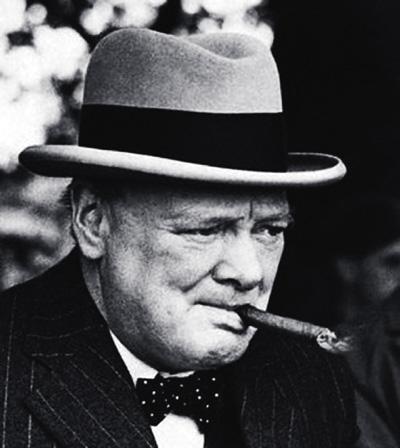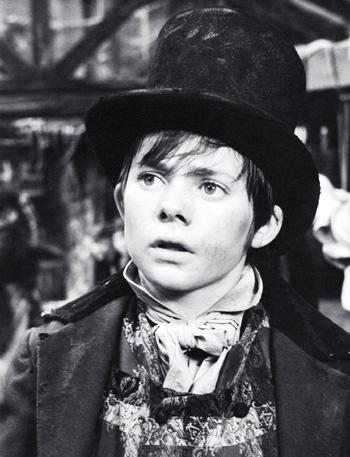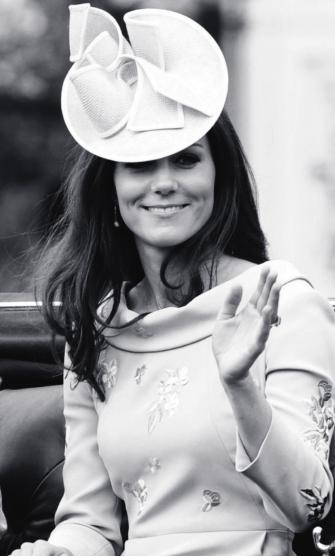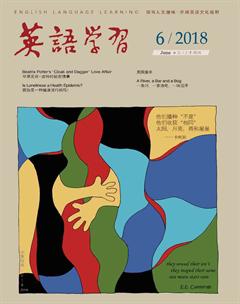英国的帽子文化
By Melvyn Braggl


Britain is a nation of hat wearers, of that there is no doubt. From the Artful Dodgers battered top hat to Winston Churchills homburg, the history of the country can be told through the hats that have graced the heads of some of our most famous luminaries.1 Traditionally hats are a very loaded item and have almost totemic power in their ability to signify class, gender, occupation and a myriad of other stations.2 Even the protocol has symbolic value; from doffing your hat to launching mortar boards in the air,3 hats have long been associated with rituals and practices stretching back into the mists of time. With the Royal Wedding throwing British millinery back into the spotlight the time is to take a tour of Britains heritage through its headwear.4
The humble flat cap can be traced back to medieval England and was even the subject of Tudor sumptuary laws.5 In an attempt to spur on the wool trade an Act of Parliament was instituted in 1571 decreeing that all males over six years old (except for the nobility) had to wear a wool cap on Sundays and holidays, with a penalty of a fine if they refused. The non-aristocratic association stuck and the flat cap became an icon of working class culture in the 19th and 20th centuries.

The hat was a trademark of a number of characters, but no one has truly made the bowler their own quite like Charlie Chaplin. The Little Tramp, icon of silent-era comedy, certainly had a penchant for accessories,6 so much so that one of his famous bowlers and a cane was sold last November for$62,500!

Archaeologist and heritage interpreter7 Sally Pointer specialises in reconstructing and creating historical hats. When asked about her favourite she comes down in favour of yet another classic: the deerstalker. It may be crystalised in the popular imagination as the hat of choice of Sherlock Holmes, but its interesting to note that there is not a single mention of him donning a deerstalker in any works by Arthur Conan Doyle.8 The deerstalker was a vital aspect of the Victorian gentlemans hunting ensemble9, worn on country estates but not in the city, and as such it certainly would not have featured in Holmes day to day life around Baker Street. The association came about when illustrator (and contemporary of Doyle) Sidney Paget gave Holmes both a deerstalker and Inverness cape10 for out of town adventures such as “The Boscombe Valley Mystery”. The connection stuck and an icon was born, albeit an inaccurate one. But for Sally Pointer this is all part of its charm: “the willingness on our part to accept a little eccentricity in an overall look fits the way the British approach hats perfectly.”
The Edwardian era was a golden age of millinery. Ornamentation became ever more elaborate, with a cornucopia of flowers, birds, lace, ribbons, bows, feathers and artificial fruit regularly gracing heads in an opulent display of conspicuous consumption.11 Hatpins were essential to secure these creations to the head. The lengthy pins were useful for discouraging dangerous advances12 on the street, so much so that laws were proposed to ban this secret weapon in many cities around the world. Hats were still a necessity in public in Edwardian Britain, the Suffragettes13 even remained beautifully behatted when chained to railings and campaigning for the right to vote.
But the hat hasnt always been a symbol of propriety. Britains rich street style and subcultural heritage has often seen the hat become somewhat subversive. Anthropologist Ted Polhemus cites the pork pie hat and the Mod14 subculture as the perfect example. Originating in the mid-19th century, the pork pie hat (named for its resemblance to the dish) was the hat of choice for many well-dressed Victorian city dwellers, but morphed into a key element of London street style a century later. Equally, not wearing a hat was seen as an act of rebellion. Polhemus recounts BBC footage of bare-headed Teddy Boys stealing a mans hat on the street which visualised the moral panic that the Teds inspired.15
During the 1940s the headscarf turban was popular for women working in factories, to stop long Veronica Lake-style hair from getting caught in machinery.16 The turban of the “Land Girl”17 symbolised the war effort, patriotism and utility, while throughout the 50s hats became an essential aspect of French couture houses, keen to reestablish their pre-eminence on the fashion stage. By the 1960s, though, the rise of car ownership and the burgeoning Youthquake ensured that hats were no longer needed either as protection from the weather or as a demarcation of class.18
There has been a renaissance in hat wearing in the 21st century, thanks to a welcome boost in 2011 when the Royal Wedding coincided with the 300th anniversary of the races at Ascot19, ensuring a vintage year for hats. Meanwhile, Stockport Hat Works Museum—the only museum in the country dedicated to hats and hat making—is more popular than ever, and staff have noticed a distinct increase in headgear on their visitors.

With hats undoubtedly in the ascendent, what marks Britain out on the world stage is the sheer number of hats we can call our own. When France has the beret, Spain has the Cordobés and Mexico has the sombrero as defining features, why do we have so many? Historian Matthew Ward professes an obsession with hats ranging from medieval liripipes to Georgian cocked hats, and believes that the variety of headgear in Britain reflects our multicultural background, with the legacy of such diversity ensuring Britain doesnt have a single national form of dress, let alone a national hat, with our headgear reflecting this rich cultural heritage.

英国是个人人都爱戴帽子的国家,这一点毫无疑问。从机灵鬼道奇破破烂烂的大礼帽到温斯顿·丘吉尔的洪堡软毡帽,这个国家的历史可以通过我们最负盛名的杰出人士头上所戴的帽子来讲述。传统上帽子是一件承载意义十分丰富的物品,有着近乎图腾一般的力量來体现阶级、性别、职业和其他各种各样的身份。甚至(有关帽子的)礼仪也具有象征意义:从脱帽到把学位帽抛向空中,帽子一直与种种古老的仪式和做法紧密联系在一起。随着皇家婚礼将英国女帽重新投入聚光灯下,时机已经成熟,是时候通过帽子来一览英国的文化传统了。
朴素的鸭舌帽可以追溯到中世纪的英格兰,甚至还曾被列入都铎王朝的禁奢法。为了刺激羊毛贸易,1571年制定的一项议会法令规定所有六岁以上的男性(除贵族外)必须在星期日和节假日戴羊毛帽,如不服从则会被罚款。这种非贵族的关联意义延续了下来,鸭舌帽成了19世纪和20世纪工人阶级文化的象征。
帽子是许多角色的标志,但没有人能像查理·卓别林那样真正让圆顶高帽成为自己的特有标志。作为默片时代的喜剧偶像,“小流浪汉”卓别林当然对配饰情有独钟,一顶他的著名圆顶高帽和一支手杖在去年11月被以62,500美元的价格售出!
考古学家和遗产解说员萨利·波因特的专长是重现和制作历史上的帽子。当被问及她最喜欢的帽子是什么时,她的答案是帽子中的又一个经典:猎鹿帽。作为福尔摩斯的标配,这种帽子似乎已经在公众的想象中根深蒂固了,但有意思的是,阿瑟·柯南·道尔的作品里从未提到过福尔摩斯戴着猎鹿帽。猎鹿帽是维多利亚时期绅士狩猎全套装备的一个重要元素,人们会在乡野宅邸里而不会在城市中佩戴它,因此猎鹿帽肯定不会出现在福尔摩斯位于贝克街的日常生活中。福尔摩斯与猎鹿帽的这种关联之所以会产生,是因为插画家(与道尔是同时代的人物)悉尼·佩吉特在如《博斯科姆比溪谷秘案》等郊外发生的冒险故事中为福尔摩斯画上了一顶猎鹿帽和外罩圆领披风。这种关联延续了下来,于是一个经典标志就此诞生——虽然不太准确。但是对于萨利·波因特来说,这正是其魅力所在:“我们愿意在整体外观上接受一点点古怪之处,这也完美地符合英国人对待帽子的方式。”
爱德华时期是女帽的黄金时代:装饰变得越来越精致,形形色色的花、鸟、蕾丝、丝带、蝴蝶结、羽毛和仿制水果经常可以在人们头上见到,珠光宝气,展现着炫耀性消费。女帽饰针对于把这些装饰品固定在头上至关重要。长长的饰针对于阻止街头危险的不轨行为非常有用,以至于全世界许多城市都提出立法禁止这种秘密武器。在爱德华时期的英国,帽子仍然是公共场合的必需品,妇女参政论者被捆在栏杆争取选举权时仍然戴着美丽的帽子。
但帽子并不总是礼仪的象征。英国丰富的街头风格以及亚文化传统就见证了帽子的颠覆性变革。人类学家泰德·波西莫斯引用了猪肉馅饼帽和Mod亚文化作为完美的例子。起源于19世纪中叶的猪肉馅饼帽(因与猪肉馅饼外形相似,故得此名)是许多衣着考究的维多利亚时期城市居民首选的帽子,但在一个世纪之后却变成了伦敦街头风格的关键元素。同样,不戴帽子曾被视为一种叛逆的行为。波西莫斯讲述了英国广播公司拍摄的视频,镜头里呈现了光头泰迪男孩们在街上偷走了一个男人的帽子后激发的道德恐慌。
上世纪40年代,头巾很受那些在工厂工作的女性欢迎,因为可以防止她们留着维罗妮卡·莱克发型的长发绞进机器。“大地女孩”的头巾象征着战争时期作出的努力、爱国精神和实用性,而在整个50年代,帽子成为法国高级时装店的一个重要元素,渴望在时尚舞台重放夺目光彩。然而到了60年代,汽车拥有率的增加和新兴的青年震荡,使得人们不再需要帽子来保护自己不受天气的影响或是作为划分阶级的标志。
21世纪帽子又复兴起来,这要归功于2011年皇家婚礼的举办,而且这一年也是英国皇家雅士谷赛马会的300周年纪念,以上两件盛事使得2011年成为了帽子的复古年。与此同时,斯托克波特帽子博物馆(英国唯一一个以帽子和制帽为主题的博物馆)比以往更受欢迎,而且博物馆员工们注意到戴帽子的游客明显增多。
毫无疑问帽子正在兴起,让英国在世界舞台独树一帜的是我们可以称之为英国特有的帽子的数量。法国有贝雷帽,西班牙有科尔多贝斯礼帽,墨西哥有宽边帽,作为各自特有的帽子,但为什么我们拥有这么多?历史学家马修·沃德对帽子(无论是中世纪的长尾兜帽还是乔治王时期的三角帽)表示痴迷,并认为英国的帽子种类之多反映了我们的多元文化背景,这种多样性的传统使得英国没有单一的民族服饰,更不用说单一的英式帽子了。我们的帽子正是这种丰富的文化遗产的反映。
1. Artful Dodger: 机灵鬼杰克·道金斯,英国作家狄更斯作品《雾都孤儿》中的人物,头脑和行动都非常灵活,他把主人公奥利弗带进贼窝;battered: 破旧的;homburg: 洪堡软毡帽;luminary:杰出人物,名人。
2. totemic: 图腾的;a myriad of: 各种各样的;station: 地位,身份。
3. protocol: 礼仪;doff: 脱帽;mortar board: 学位帽。
4. Royal Wedding: 这里应指2011年威廉王子大婚;millinery: 女帽。
5. Tudor: 都铎王朝(1485—1603),伯爵亨利·都铎于1485年8月在法国援助下杀死理查三世,夺取王位,建立都铎王朝,史称亨利七世。都铎王朝统治英格兰王国直到1603年伊丽莎白一世去世为止,历经120余年,共经历了五代君主;sumptuary law: 禁奢法,是用以规范消费行为的法律条文,目的是控制奢侈浪费,尤其反对配饰、食物、家具等的浪费与过度消耗。
6. The Little Tramp: 卓别林的昵称之一;penchant: 偏好。
7. heritage interpreter: 遗产解说员,指在博物馆、公园、水族馆等地帮助人们了解文化或自然遗产价值的解说员。
8. crystalise: 使……成形,使……具体化;don: 戴上,穿上。
9. ensemble: 全套服装。
10. Inverness cape: 一种(披肩可脱卸的)无袖长披风。
11. cornucopia: 丰盛,大量;opulent: 华丽的,奢侈的。
12. advances: (常用复数)靠近,(对异性的)挑逗。
13. Suffragette: // 妇女参政论者,指的是19世纪末20世纪初不惜通过暴力运动争取妇女参政权的女性。
14. Mod: 一种亚文化,起源于上世纪50年代末的伦敦,mod一词来源于“modernist”。最早期的Mod族是劳工阶级的下一代,二战结束士兵返家后,其子女约处在青少年叛逆的年纪,因为和父母沟通的代沟、战后的不安以及郊区生活的乏味苦闷,让这些青少年在压抑的生活中想要表现自我。代表Mod精神的是蓝白红三色同心圆箭靶符号。
15. footage: (电影的)连续镜头;Teddy Boys: 泰迪男孩,英国亚文化,20世纪50年代在伦敦开始形成,随后在英国各地迅速蔓延,与摇滚乐联系紧密。除了身着独具风格的服装,他们的发型也很有特色,在头顶抹厚厚的油,脑后则留成鸭屁股式的扁平发型。
16. turban: 包头巾;Veronica Lake: 维罗妮卡·莱克(1922—1973),出生于纽约布鲁克林,美国电影演员,20世纪40年代以金色长发引领一代时尚。
17. Land Girl: 1941年,二戰战火正炽,英国的年轻男子纷纷被征召赴前线作战。于是在后方的家乡,有一群英国年轻女子组成“妇女家乡工作服务队”,她们的工作是被分派到全国各地,到乡间的农场从行各种农事。
18. burgeoning: 迅速发展的;Youthquake:是青年(Youth)与地震(quake)的合成词,意指年轻人的行为对政治、社会或文化变迁造成重大的影响。该词最早出现于上世纪60年代,指当时大批英国青年推动时尚界的复古再流行。2017年6月,英国媒体报道英国国会选举时因当时年轻人投票率激增,对保守党形成重要影响,因而重新使用该词。该词后来也出现在美国、澳大利亚、新西兰等国的政治评论中,并于2017年入选牛津词典;demarcation:划界。
19. 英国皇家雅士谷赛马会,设立于1711年,每年六月举行,被认为是世界上最豪华奢侈的赛马会,传统的英国人对此非常自豪。这项赛事更是英国上流社交圈的大事,从皇室贵族到一般平民都会在这天大肆庆祝。从1807年开始,英国皇家雅士谷赛马会首次将比赛的第三天定为“金杯日”,因为这天是整个赛程最关键的一天。不过很多英国人包括英国王室却习惯地称之为“仕女日”(Ladies Day),因为当天大批盛装打扮的女性观众都会前来观赛,这里成了英伦女士们展示高级时尚和创意帽饰的伸展台。英国的赛马季就等于时装节或帽展,绅士淑女个个争奇斗艳。

